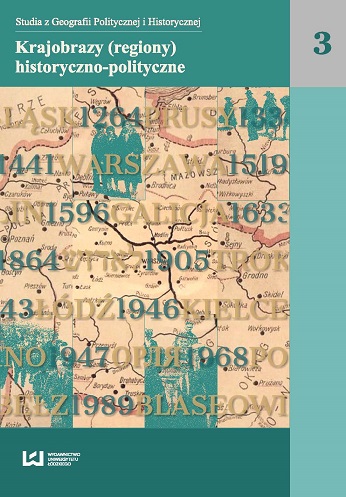Ślady kultury materialnej i duchowej Tybetańczyków na obszarach współczesnych prowincji Syczuan i Qinghai
DOI:
https://doi.org/10.18778/2300-0562.03.10Słowa kluczowe:
region historyczno-polityczny, region historyczno-kulturowy, dziedzictwo kulturowe, Tybetańczycy, wsie tybetańskie, klasztory buddyjskieAbstrakt
W artykule przedstawiono przykłady pozostałości kultury materialnej i duchowej Tybetańczyków w prowincjach Syczuan i Qinghai, znajdujących się współcześnie poza granicami Tybetańskiego Regionu Autonomicznego. Przedstawiono wieś tybetańską Jiaju z rejonu Danba i obiekty kultury sakralnej. Jednym z nich jest klasztor Kumbum (Ta’er Si), odgrywający znaczącą rolę w buddyzmie tybetańskim. Obiekty te ocalały pomimo ogromnych zniszczeń, jakich dokonano podczas rewolucji kulturalnej, i dowodzą ciągłości osadniczej Tybetańczyków na tych ziemiach. Zwrócono także uwagę na pielęgnowanie tradycji ludowych (śpiewu, tańca, strojów), które są bardzo istotne w zachowaniu tożsamości narodowej.
Bibliografia
Dohnalová M., Nejstarší tibetské dějiny a tři dharma králové: http://www.tibinfo.cz/clanek.php?id=60; (14.06.2014).
Google Scholar
French P., 2007, Tybet, Tybet, tłum. J. Halbersztat, Ushuaia.pl, Warszawa.
Google Scholar
Kalmus M., 2008, Tybet. Legenda i rzeczywistość, Wydawnictwo Bezdroża, Kraków.
Google Scholar
Larid T., 2008, Opowieść o Tybecie. Rozmowy z Dalajlamą, Dom wydawniczy Rebis, Poznań.
Google Scholar
Li Chunsheng Chen Yong, 2007, China’s minority people, China Pictorical Publishing House, Beijing.
Google Scholar
Loucks C.J., Zhi L., Dinerstein E., Dajun W., Dali F., Hao W., 2003, The giant pandas of the Qinling Mountains, China: a case study in designing conservation landscape for elevational migrants, „Conservation Biology”, 17, s. 558–565.
Google Scholar
DOI: https://doi.org/10.1046/j.1523-1739.2003.01494.x
Papińska E., 2010, Rola mniejszości narodowych i etnicznych w rozwoju turystyki, [w:] Krajobrazy rekreacyjne – kształtowanie, wykorzystanie, rekreacja, Problemy Eko logii Krajobrazu, t. 27, Warszawa–Biała Podlaska, s. 301–312
Google Scholar
Papińska E., 2012, Uwarunkowania rozwoju turystyki na przykładzie wybranych geoparków Chin, „Annales Universitatis Mariae Curie-Skłodowska. Lublin-Polonia”, 67 (2), s. 63–75.
Google Scholar
DOI: https://doi.org/10.2478/v10066-012-0020-9
Szolginia W., 1992, Architektura, Sigma NOT, Warszawa.
Google Scholar
Szymczak A. i M., 2008, Tybet. W kraju ginącej kultury, Wydawnictwo terraQuest, Warszawa.
Google Scholar
Wall Ł., 2008, Tybet. Kraj na Dachu Świata, Wydawnictwo Świat Książki, Warszawa.
Google Scholar
http://en.wikipedia.org/wiki/Autonomous_prefectures_of_the_People%27s_Republic_of_China (11.06.2014).
Google Scholar
http://en.wikipedia.org/wiki/Autonomous_counties_of_the_People%27s_Republic_of_China (11.06.2014).
Google Scholar
http://en.wikipedia.org/wiki/Qinghai (13.06.2014).
Google Scholar
http://en.wikipedia.org/wiki/Qinghai_Lake (13.06.2014).
Google Scholar
http://pl.wikipedia.org/wiki/Syczuan (13.06.2014).
Google Scholar
http://whc.unesco.org/en/list/637 (2.02.2011).
Google Scholar
DOI: https://doi.org/10.1039/c1fo90034j
http://www.unesco.org/pg.cfm?cid=31&id_site=638 (2.02.2011).
Google Scholar
http://english.agri.gov.cn/news/dqnf/201404/t20140401_21551.htm (14. 06. 2014).
Google Scholar
Pobrania
Opublikowane
Jak cytować
Numer
Dział
Licencja

Utwór dostępny jest na licencji Creative Commons Uznanie autorstwa – Użycie niekomercyjne – Bez utworów zależnych 4.0 Międzynarodowe.








